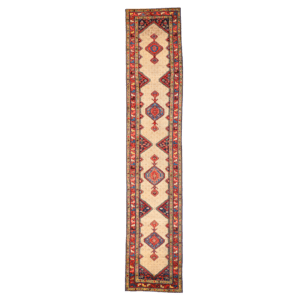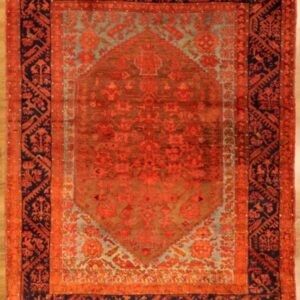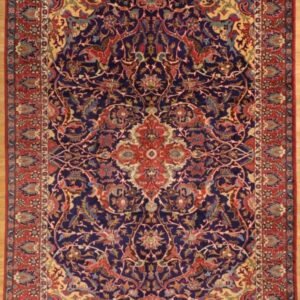Serial No.: 0009782
Origin: Persia, Malayer
Age: Late 19th Century
Style: Tribal Weaving
Size: 2’5″ x 12’1″
Material: Wool Foundation, Wool Pile, Vegetable Dyes
Color Scheme: Ivory Field, Salmon, Turquoise, Navy, Camel Hair
Expert Description
This extraordinary late 19th-century Persian rug from Malayer is a rare specimen of tribal weaving that embodies both traditional artistry and innovative design. With dimensions of 2’5″ x 12’1″, its elongated runner format is accentuated by a nearly seamless geometric center field and four prominent medallions, making it a standout piece for collectors and interior enthusiasts seeking authentic antique Persian rugs.
Regional Heritage and Malayer Significance
Malayer, located in the heart of Iran’s rich carpet-weaving regions, has long been celebrated for producing rugs that marry robust construction with refined, intricate patterns. Historically, Malayer rugs have been prized for their unique blend of tribal motifs and sophisticated design elements, and this piece is no exception. Its design reflects a synthesis of local traditions and the broader Persian heritage, offering a window into the cultural and artistic practices of the late 19th century.
Design Elements and Visual Impact
At the core of the rug lies an expansive field rendered in an elegant ivory tone, which serves as the perfect backdrop for a dynamic interplay of color. Four medallions are strategically placed, each showcasing detailed tribal motifs that exude both symmetry and visual rhythm. The medallions—executed in vibrant salmon, turquoise, navy, and accented with touches of camel hair—create a dramatic contrast against the ivory field. This almost seamless geometric center field, typical of elite tribal designs, invites close inspection and sets the piece apart as an unusual and innovative example of Persian tribal weaving.
Weaving and Dyeing Techniques
Crafted with a wool foundation and a dense wool pile, the rug employs traditional hand-knotted techniques passed down through generations of Persian weavers. The precision of the single knotting method, often referred to as the Turkish or symmetrical knot, ensures that every medallion and geometric element is rendered with remarkable clarity and durability.
The use of natural vegetable dyes is a hallmark of this region’s carpet production. Sourced from local plants and minerals, these dyes produce rich, layered hues that evolve over time. For instance, madder root likely contributes to the salmon tones, while indigo or other natural blue pigments yield the deep turquoise and navy accents. The resulting abrash, or slight tonal variation, enhances the rug’s authentic, timeworn charm and distinguishes it as a product of traditional dyeing practices.
Historical Context and Areas of Use
In its era, a rug of this size and complexity would have been highly valued both for its functional utility and as a symbol of status in Persian households. Traditionally, such antique Persian tribal rugs were used to adorn the floors of noble residences or served as wall hangings in formal settings to convey cultural prestige. Today, this Malayer rug can serve as an exceptional accent piece in living rooms, hallways, or dining areas. Its elongated format makes it ideal for defining space, while its unique design can also be displayed as a wall hanging, offering an artistic narrative that bridges history and contemporary style.
SEO Keywords: Antique Persian rug from Malayer, late 19th-century tribal weaving, traditional Persian carpet with medallions, hand-knotted wool rug with vegetable dyes, authentic Persian tribal rug, antique geometric medallion rug, traditional Malayer rug for living room, eco-friendly Persian rug, collectible antique Persian carpet.







Reviews
There are no reviews yet.